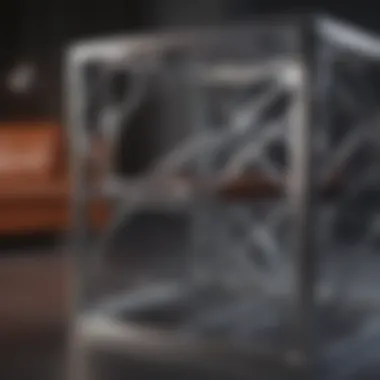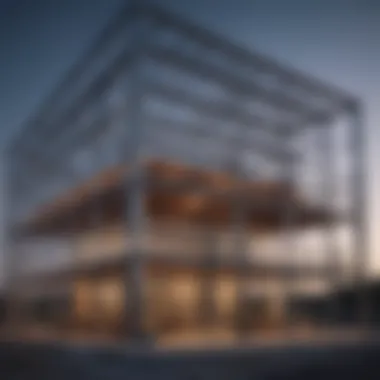Exploring the Aluminum Framework: Properties and Innovations


Intro
Aluminum frameworks have emerged as pivotal elements in modern engineering, demonstrating versatility and strength across various applications. The material itself is lightweight and resistant to corrosion, a combination that makes it an attractive choice for industries from construction to aerospace. In examining aluminum frameworks, one must consider their properties, innovative techniques, and real-world applications, all of which contribute to a more sustainable and efficient future.
This article delves into the core aspects that define aluminum frameworks. We will explore their structural integrity, the technological advancements that have led to their increased use, and the implications for sustainability in engineering practices. By analyzing current research and case studies, readers will better understand how aluminum frameworks are not just supporting structures but are also enhancing functionality in numerous fields.
Intro to Aluminum Frameworks
The aluminum framework is a significant topic in modern engineering and architecture. Its lightweight nature, combined with exceptional strength, makes it a preferred choice in various applications. As industries look for materials that not only fulfill structural requirements but also improve efficiency, aluminum stands out. This article will elucidate crucial aspects of aluminum frameworks, including their properties, advantages, and innovative applications across multiple domains.
Definition and Overview
Aluminum frameworks refer to structures or systems constructed primarily from aluminum materials. This can involve beams, columns, trusses, or other supportive elements. Their main attributes include durability, corrosion resistance, and a favorable weight-to-strength ratio. These characteristics allow aluminum frameworks to be versatile in various settings, from buildings to vehicles.
The significance of aluminum frameworks extends beyond just material properties. They embody a blend of engineering elegance and practical utility, often resulting in designs that are both aesthetically pleasing and functionally robust. Moreover, their alignments with sustainability goals, such as recyclability and energy efficiency, add to their relevance in contemporary manufacturing processes.
History and Development
To appreciate the role of aluminum frameworks today, one must look at their evolution. Aluminum gained prominence in construction and manufacturing during the early 20th century. Before this material was widely used, frameworks were predominantly made from steel or wood, each with distinct limitations.
The introduction of aluminum into these fields offered new possibilities. Its lightweight feature allowed for more expansive structures with reduced loads on foundations. During World War II, aluminum's utility accelerated; it became crucial in the aerospace industry due to its favorable properties.
In the decades that followed, advancements in manufacturing processes further enhanced aluminum's desirability. Techniques such as extrusion and welding were developed, facilitating the creation of complex and sturdy frameworks. Today, with continued innovations, aluminum has solidified its place in various applications, marking a transformative journey from niche material to industry standard.
Properties of Aluminum
The properties of aluminum are pivotal to understanding its role in engineering and architecture. Aluminum’s unique characteristics endow it with advantages that many other materials cannot match. Strength combined with lightweight aspects allows for innovative designs. Understanding these properties helps in optimizing applications across diverse fields.
Mechanical Properties
Mechanical properties relate to how the material behaves when subjected to various forces. These include tensile strength, flexural rigidity, and fatigue resistance. Each aspect contributes significantly to the structural capabilities of aluminum frameworks.
Tensile Strength
Tensile strength indicates how much pulling force a material can withstand before breaking. It is a crucial factor for any structural application. Aluminum tends to have high tensile strength, making it a favorable choice in design. This property is beneficial in applications requiring substantial load-bearing. The unique feature of tensile strength is its ability to maintain integrity under stress without excessive elongation. However, this can also mean that when overloaded, the material may fail unexpectedly without prior yielding.
Flexural Rigidity
Flexural rigidity measures a material's resistance to bending under load. This property is essential when aluminum is used in beams and frameworks. The high flexural rigidity of aluminum ensures structures remain stable and do not deform over time. Designers appreciate this feature for constructing lightweight yet solid frameworks. On the downside, while it has excellent resistance to bending, improper design can still lead to localized failures if concentrated loads are not managed well.
Fatigue Resistance
Fatigue resistance refers to a material's ability to withstand repeated loading and unloading cycles. It's critical for aluminum frameworks that experience variable loads, such as in transportation applications. Aluminum often exhibits good fatigue resistance, making it a reliable option in construction and automotive industries. However, fatigue failure can occur over time, especially when the material is subjected to environment factors like temperature fluctuations.
Physical Properties
Moving to physical properties, these characteristics influence practical applications. The weight-to-strength ratio, corrosion resistance, and thermal conductivity are significant indicators of aluminum's effectiveness in various roles.
Weight-to-Strength Ratio
Aluminum boasts an exceptional weight-to-strength ratio, which defines its strength in relation to its weight. This property is critical for applications where minimizing weight is vital without compromising structural integrity. A lower weight leads to easier handling and faster construction. The unique feature lies in how it allows for substantial design freedom. However, this property requires careful consideration during fabrication to avoid compromises on structural safety.
Corrosion Resistance
Aluminum's natural oxide layer grants it remarkable corrosion resistance. This feature is particularly advantageous in construction and outdoor applications. Structures utilizing aluminum frameworks thrive in harsh environmental conditions without extensive maintenance. The downside, however, is that in certain specific environments, like marine settings, extra coatings or treatments might be necessary for prolonged durability.
Thermal Conductivity
Thermal conductivity is crucial when aluminum is used in applications involving heat transfer. Aluminum efficiently conducts heat, which is beneficial in systems requiring temperature regulation, such as heat exchangers. This property also allows for rapid thermal response in various applications. The unique feature of aluminum’s thermal conductivity supports energy efficiency. However, its high thermal conductivity can lead to unwanted heat loss in some applications, necessitating insulation.
Understanding these properties enables engineers to make informed decisions, enhancing the performance and durability of aluminum frameworks.
Understanding these properties enables engineers to make informed decisions, enhancing the performance and durability of aluminum frameworks.
Advantages of Aluminum Frameworks
The use of aluminum frameworks has become increasingly prominent across various sectors due to their distinctive advantages. These advantages not only make aluminum frameworks practical but also elevate their relevance in modern engineering and construction. Highlighting the benefits is crucial, as it showcases how these frameworks respond to the evolving demands of industries and environmental considerations.
Lightweight Nature


One of the most significant advantages of aluminum frameworks is their lightweight nature. The low density of aluminum facilitates easier handling and installation compared to heavier materials like steel or concrete. Structural components can be constructed with reduced overall weight without sacrificing strength. This lightweight property also means less energy is required for transportation and assembly, leading to a more sustainable project design.
In construction, for example, the ease of working with lighter materials can speed up project timelines. Workers can move larger components with less effort. This feature is beneficial not only for labor efficiency but also for reducing the overall carbon footprint of construction projects.
Furthermore, lighter structures may lead to reduced foundation requirements, allowing for more flexible site designs. In areas with specific geological challenges, this aspect can be especially advantageous, making aluminum frameworks a preferred choice.
Cost-Effectiveness
Aluminum frameworks offer a cost-effective solution in many applications. Although the initial cost of aluminum can be higher than alternative materials, the long-term savings are substantial. Maintenance costs tend to be lower because aluminum is highly resistant to corrosion, reducing the need for frequent repairs and replacements.
The durability of aluminum means structures can endure environmental stresses better than some other materials, prolonging their lifespan. Additionally, the recycling aspect of aluminum contributes to its overall cost-effectiveness. Using recycled aluminum requires only a fraction of the energy needed to produce new aluminum, leading to reduced costs for manufacturers and consumers alike.
Moreover, projects employing aluminum frameworks often experience quicker returns on investment thanks to shorter construction times and lower maintenance. The financial viability of aluminum, thus, enhances its attractiveness in both residential and commercial applications.
Versatility and Adaptability
The versatility and adaptability of aluminum frameworks are fundamental to their broad range of applications. Aluminum can be easily extruded or molded into various shapes and sizes, catering to specific project needs. This flexibility allows engineers and architects to innovate while designing structures that require unique frame configurations, such as in modern architecture.
Furthermore, aluminum frameworks can be employed in a variety of environments, from residential homes to large commercial buildings, as well as temporary installations for events or exhibitions. The ability to easily modify aluminum structures makes them suitable for changing requirements, whether during the construction phase or later during use.
Aluminum's compatibility with other materials also enhances its adaptability. It can seamlessly integrate with materials like glass and wood, leading to aesthetic designs that do not compromise functionality. The result is structures that can meet rigorous structural demands while also being visually appealing.
"Aluminum frameworks redefine engineering possibilities by marrying strength with lightweight convenience, ultimately advancing sustainable practices."
"Aluminum frameworks redefine engineering possibilities by marrying strength with lightweight convenience, ultimately advancing sustainable practices."
Applications of Aluminum Frameworks
Aluminum frameworks have gained notable attention across multiple sectors. Their attributes contribute significantly to structural designs and functionality. The lightweight nature combined with strength enables efficient implementations. Moreover, these frameworks offer sustainable solutions that comply with modern environmental regulations. As industries seek versatile materials, aluminum frameworks stand as a smart investment. They play pivotal roles in construction, transportation, and industrial fields, showcasing their adaptability in meeting various demands.
Construction and Architecture
Residential Buildings
In residential buildings, aluminum frameworks provide essential support. The lightweight structure allows for easier transportation and installation, reducing overall labor costs. Such designs are also intuitive for architects looking to create open spaces without heavy load-bearing walls. They help in achieving modern aesthetic designs efficiently. A specific characteristic is corrosion resistance. This ensures longevity and less maintenance, making it an popular choice.
One key feature of residential buildings utilizing aluminum frameworks is the possibility for modular construction. This aligns perfectly with contemporary needs for rapid build times, contributing to a lower carbon footprint.
Commercial Structures
Commercial structures benefit from using aluminum frameworks too. The layouts often demand larger open areas, which aluminum can accommodate effectively. Its high strength-to-weight ratio offers significant advantages, such as reducing the need for extensive foundations. Durability also plays a role; commercial buildings require reliable materials that withstand wear over time.
The unique feature of commercial structures is their ability to support extensive glazing systems. Such designs create inviting interiors without compromising structural integrity.
Temporary Installations
Temporary installations present yet another perspective on aluminum frameworks. In events or exhibitions, the need for adaptable and lightweight solutions becomes critical. Aluminum frameworks are easy to assemble and disassemble, proving efficient for temporary setups. They provide significant flexibility. Notably, they can be reused multiple times, which supports sustainability efforts.
The key characteristic of temporary structures made of aluminum is their portability. This flexibility enhances accessibility and allows for imaginative designs, which are appealing for their intended purposes.
Transportation
Aerospace
In the aerospace sector, aluminum frameworks are indispensable. The specific aspect of weight reduction directly translates to efficiency in flight. Using aluminum means planes are lighter, which leads to fuel savings. Moreover, aluminum’s corrosion resistance becomes vital given the harsh conditions faced in aviation.
A key feature here is the material's ability to be shaped into complex forms without loss of strength. This promotes aerodynamic designs, improving performance and safety.
Automotive
For the automotive industry, aluminum frameworks make a substantial contribution. Many manufacturers are turning to aluminum to enhance fuel efficiency and performance. Automobiles built with aluminum exhibit reduced weight without sacrificing safety. This change is driving the evolution towards more sustainable vehicles.
Automotive frameworks also present a unique feature: recyclability. The use of recycled aluminum not only conserves resources but also reduces the carbon footprint associated with production.
Railway Systems
Railway systems increasingly employ aluminum frameworks. Their lightweight nature translates into reduced energy consumption for trains. Additionally, aluminum enables faster and more efficient construction of railway lines and stations, addressing the pressing demands for expanded infrastructure.
A distinguishing element of aluminum in railway systems is its increased durability. It withstands the various stresses and weather conditions trains endure, ensuring lower maintenance costs in the long run.


Industrial Applications
Manufacturing Equipment
In manufacturing, unlike traditional weighty alternatives, aluminum frameworks are gaining traction. Their strength enables the production of robust equipment while maintaining a lower weight. This feature significantly aids the operation of machinery, improving overall performance.
Using aluminum also lends to enhanced design flexibility. Manufacturers can create highly efficient systems that are tailored to specific applications, maximizing productivity.
Storage Solutions
Aluminum frameworks are ideal for storage solutions, particularly in warehouses. Their lightweight nature allows for tall shelving that does not compromise structural integrity. This vertical capacity expands storage efficiency significantly.
One clear advantage is the ease of reconfiguration. Businesses often need to adapt their layout to changing inventory or workflow patterns. Aluminum frameworks simplify this process, improving operational dynamism.
Modular Systems
The concept of modular systems in industrial applications is evolving. Aluminum frameworks enable versatile configurations that meet various manufacturing and logistical needs. The ability to reconfigure spaces quickly enhances efficiency and responsiveness.
A unique trait of modular systems is their easy scalability. Businesses can start with a small setup and expand as needed, minimizing initial costs while maximizing growth opportunity.
By understanding the far-reaching implications of aluminum frameworks, professionals across industries can make informed choices, fostering innovation and sustainability.
Innovations in Aluminum Framework Technologies
Innovations in aluminum framework technologies represent a vital advancement in engineering and manufacturing. This section emphasizes the role that new techniques play in enhancing the performance, efficiency, and application scope of aluminum frameworks. The ongoing developments are not only crucial for material optimization but also have significant implications for sustainability in various industries. With innovations fostering lightweight yet durable structures, they lead to improved designs that meet modern demands without compromising on resource conservation.
Advanced Manufacturing Techniques
3D Printing
3D printing is transforming how aluminum frameworks are designed and produced. The specific aspect of this technology allows for rapid prototyping and manufacturing of complex geometries which are traditionally difficult to fabricate. Key characteristic of 3D printing is its ability to significantly reduce waste material during the production process. By building layers of material, it uses only what is necessary for each part. This makes it a beneficial choice for small-batch production and customized applications.
One unique feature of 3D printing is its capability to create intricate designs that maximize structural integrity while minimizing weight. However, there are some disadvantages as well, such as slower production rates compared to conventional methods for larger quantities, and the initial costs of high-quality equipment can be prohibitive. Despite these challenges, its adaptability makes 3D printing an attractive option in the world of aluminum frameworks.
Forging Processes
Forging processes represent another critical technique in the aluminum framework landscape. This manufacturing method enhances the intrinsic properties of aluminum by shaping it under high pressure and temperature. The key characteristic of forging processes is the resultant strength and durability of the finished products. These aspects make it a popular choice for applications demanding high-performance standards.
A unique feature of forging is its ability to align the metal's grain structure, leading to enhanced mechanical properties such as fatigue resistance. However, forging processes often require significant energy and investment in tooling, which can limit their appeal for smaller projects. Nevertheless, the benefits of superior strength and reliability provide compelling reasons to consider forging for various aluminum framework applications.
Smart Materials and Integration
Embedded Sensors
Embedded sensors in aluminum frameworks signify a notable shift towards the integration of smart technologies. The specific aspect of including these sensors allows structures to monitor their conditions in real time. The key characteristic of embedded sensors is their ability to collect data on stress, temperature, and other vital parameters. This makes them a beneficial innovation for enhancing safety and performance in various settings.
A unique feature of these sensors is their unobtrusive nature, which allows them to be integrated seamlessly into the aluminum structure without affecting aesthetics or functionality. On the downside, the initial costs and complexity of installation can be barriers to widespread adoption. Despite these considerations, the advantages in maintenance and safety far outweigh the drawbacks, making them an excellent addition to modern aluminum frameworks.
Data-Driven Structures
Data-driven structures represent the next frontier in aluminum framework technology. This concept leverages big data and analytics to optimize design and operation. The specific aspect of data-driven structures is their focus on performance optimization through detailed analysis of operational data. The key characteristic that underscores this innovation is the ability to adapt and evolve based on real-time data insights, making these structures highly efficient and responsive.
The unique feature of data-driven designs is their capacity for predictive maintenance, which significantly reduces downtime and extends the lifespan of structures. However, reliance on data systems introduces challenges, including potential cybersecurity issues and the need for ongoing system evaluations. Despite these hurdles, the impact of data-driven technologies on the efficiency and sustainability of aluminum frameworks is profound.
Environmental Impact and Sustainability
In recent years, the dialogue surrounding environmental responsibility has intensified. This has led to an increased focus on sustainable materials and practices in various industries. Aluminum frameworks stand out in this context due to their unique properties and environmental advantages. Understanding the environmental impact of these materials, alongside their sustainability practices, is crucial for students, researchers, educators, and professionals alike.
The use of aluminum frameworks not only promises structural integrity but also contributes favorably to ecological considerations. Notably, aluminum is highly recyclable, which plays a pivotal role in reducing waste and conserving resources. Furthermore, examining the life cycle of aluminum products provides insights into their long-term sustainability, demonstrating that they can be used for a plethora of applications with minimal harm to the environment.
Recyclability of Aluminum
Aluminum's recyclability is one of its most significant advantages. This metal can be recycled repeatedly without losing its properties. Approximately 75% of all aluminum ever produced is still in use today. The recycling process significantly reduces energy consumption compared to new aluminum production. For instance, making aluminum from recycled materials requires only about 5% of the energy used in initial production.
Key benefits of aluminum recycling:
- Energy Efficiency: A considerable reduction in energy consumption helps mitigate carbon emissions.
- Resource Conservation: Recycling aluminum preserves finite natural resources like bauxite ore.
- Economic Viability: Recycling provides a cost-effective alternative, lowering material costs for manufacturers.
Aluminum recycling initiatives and programs have gained popularity worldwide, encouraging both industries and consumers to participate in sustainable practices. This collective effort ensures that resources are utilized efficiently and responsibly.


Life Cycle Assessment
Life Cycle Assessment (LCA) is a systematic approach to evaluating the environmental impact of a product (cradle to grave). For aluminum frameworks, conducting an LCA reveals several critical insights into their sustainability.
An LCA typically encompasses the following stages:
- Raw Material Extraction: Assessing the impact of mining bauxite ore.
- Production Process: Evaluating energy use and emissions during aluminum production.
- Usage Phase: Analyzing the efficiency of aluminum frameworks in various applications.
- End-of-Life Management: Understanding the benefits and impacts of recycling or disposing of aluminum.
Each phase of the life cycle provides opportunities for improvement. Through LCA, companies can identify stages with significant environmental footprints, making informed decisions to enhance sustainability practices.
"Sustainable materials are not just beneficial; they are necessary for our future. Aluminum frameworks exemplify this balance of utility and ecological consciousness.”
"Sustainable materials are not just beneficial; they are necessary for our future. Aluminum frameworks exemplify this balance of utility and ecological consciousness.”
In summary, focusing on the recyclability of aluminum and conducting thorough life cycle assessments are vital strategies in promoting sustainability in construction and other applications. Adopting such practices not only advances environmental goals but also promotes economic benefits across industries.
Challenges and Limitations
The discussion of aluminum frameworks must include an understanding of their challenges and limitations. While aluminum offers many benefits, it is not without issues. Recognizing these factors is crucial for engineers, architects, and project managers when deciding to use aluminum in their designs and applications. It helps in planning, budgeting, and ensuring longevity of structures.
Cost Implications for Large-Scale Projects
In large-scale projects, the cost implication of using aluminum frameworks often becomes a significant concern. Aluminum is generally more expensive than traditional materials like steel. This can be due to several reasons, including:
- Material Costs: Aluminum is costly to extract and process. The mining and refining processes require significant energy, which adds to the overall price of aluminum.
- Fabrication and Assembly: Custom fabrication of aluminum parts may require specialized skills and equipment. This can further increase labor costs.
- Supply Chain Factors: Fluctuations in the aluminum market can lead to unpredictable price changes. For large projects, budget overruns may occur if prices spike unexpectedly.
Projects that rely heavily on aluminum must carefully assess these costs against projected benefits. Understanding the full financial picture ensures that stakeholders make informed decisions that will not adversely impact project feasibility.
Material Fatigue and Maintenance Issues
Another important limitation of aluminum frameworks is material fatigue and maintenance issues. Although aluminum has good fatigue resistance, it still requires regular assessment:
- Fatigue Performance: With repeated loading and unloading, aluminum can degrade over time. This can be significant in applications where structural frameworks undergo dynamic stresses, such as in transportation fields.
- Maintenance Needs: Despite its corrosion resistance, the surfaces of aluminum frameworks can be prone to wear and tear. Environmental factors such as moisture and pollution can cause surface degradation. Regular maintenance is essential to monitor these conditions and take corrective measures.
Addressing these maintenance concerns is critical to ensure long-term performance. Implementing a scheduled inspection and maintenance program can mitigate risks associated with material fatigue. This approach extends the life of aluminum frameworks and preserves their structural integrity.
Future Trends in Aluminum Frameworks
Future trends in aluminum frameworks represent a pivotal area of exploration within the context of modern engineering and construction. As industries increasingly prioritize sustainability, the role of aluminum in structural applications has gained considerable traction. The lightweight nature of aluminum complements green technologies, making them an ideal choice for forward-thinking projects. Sustainability is not merely a trend but a necessity for reducing environmental impact and optimizing resource management. Given the properties of aluminum, its relevance is magnified in terms of durability and recyclability, aligning well with global initiatives aimed at reducing carbon footprints.
Integration with Green Technologies
The integration of aluminum frameworks with green technologies has become a prominent focus for architects and engineers. This integration allows for energy-efficiency enhancements in buildings and infrastructures. For example, aluminum can be combined with solar panels in designs that maximize energy capture. Advanced techniques, such as utilizing photovoltaic cells embedded in aluminum structures, exemplify this innovation. Additionally, the use of thermal insulation materials that work in tandem with aluminum frames contributes to improved energy efficiency.
Benefits of this integration include:
- Reduced Energy Consumption: Incorporating aluminum with smart technologies reduces the overall energy demand.
- Enhanced Aesthetic Appeal: Aluminum offers design flexibility, which architects leverage to create visually appealing green buildings.
- Sustainable Lifecycle: Aluminum's recyclability means that when a structure reaches its end, the materials can be reused without significant degradation in quality.
Evolving Market Applications
The evolution of market applications for aluminum frameworks is noteworthy as industries adapt to new requirements and standards. As countries develop stricter building codes focusing on sustainability and efficiency, aluminum is positioned uniquely to meet these challenges. The automotive industry, for instance, is increasingly adopting aluminum due to its lightweight nature, contributing to better fuel efficiency in vehicles. In construction, aluminum scaffolding systems have gained popularity for their ease of installation and transportability.
Emerging applications are manifesting in various sectors. Some notable developments include:
- High-Performance Sports Equipment: Aluminum is utilized in making lighter, stronger sporting gear.
- Modular Construction: The trend towards modular building practices benefits from aluminum's lightweight and durable nature, allowing for faster assembly and disassembly.
- Aerospace Innovations: Aircraft manufacturers are now focusing on aluminum-lithium alloys to achieve lower weight without sacrificing strength.
As market demands shift, the adaptability and robustness of aluminum frameworks ensure they remain at the forefront of innovative engineering solutions. This evolution is not just about meeting existing demands but also about anticipating future trends, ultimately guiding the path for aluminum in various industries.
Epilogue
The conclusion serves as a critical final section that encapsulates the discussions and insights presented throughout the article. It connects the various threads of aluminum frameworks, drawing attention to their broad applications and the implications for future developments. This part is important because it not only recaps significant points but also encourages readers to consider the ongoing evolution in this field.
Summary of Key Insights
The key insights from our exploration reveal that aluminum frameworks are more than just structural elements; they play an instrumental role in reshaping modern construction and design. Throughout this article, several vital aspects have emerged:
- Efficient Material Properties: Aluminum offers exceptional strength-to-weight ratios, corrosion resistance, and versatility.
- Widespread Applications: From the construction of residential buildings to innovative transportation solutions, the utilization of aluminum frameworks is diverse, showcasing adaptability in various sectors.
- Sustainability: The recycling potential of aluminum combined with advanced manufacturing techniques highlights its significance in promoting sustainability in engineering practices.
- Innovations: Recent advancements, such as 3D printing and the integration of smart materials, suggest exciting possibilities for the future of aluminum frameworks.
These insights demonstrate that aluminum frameworks are deeply intertwined with contemporary engineering challenges and technological trends.
The Path Forward
Looking ahead, the trajectory of aluminum frameworks seems promising. As industries continue to prioritize sustainability and efficiency, the demand for such frameworks is likely to grow. Key considerations for the future include:
- Integration with Green Technologies: Companies will increasingly seek to incorporate aluminum frameworks with renewable energy solutions, potentially enhancing energy efficiency.
- Development of New Applications: As engineering problems evolve, novel applications for aluminum frameworks will likely emerge, driven by industries' demand for lightweight yet strong materials.
- Resilience and Maintenance Solutions: Research into the longevity and maintenance of aluminum structures will be vital. Finding efficient ways to monitor and extend their lifespan can lead to benefits in cost and resource management.







